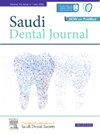Surface roughness and color change of methacrylate and ormocer-based direct composite versus indirect CAD/CAM composite blocks
IF 2.3
Q3 DENTISTRY, ORAL SURGERY & MEDICINE
引用次数: 0
Abstract
Objectives
To assess the color stability and surface roughness of resin-free and resin-based nanohybrid composites after immersion in various staining media.
Methods
A resin-free ormocer composite, Admira fusion (Voco, Germany), and a methacrylate resin composite, Grandio (Voco, Germany), were used for direct composite restorations with 30 discs per material formed using a Split Teflon mold (10 mm × 2 mm). Grandio Bloc (Voco, Germany) universal indirect CAD/CAM block specimens (n = 30) were sliced to a thickness of 2 mm with a precision saw. Each material was divided into 3 groups (n = 10 each) based on the immersion solution. Specimens were soaked in coffee (Turkish coffee, Baja, Saudi Arabia), cola (Coca-Cola Co., USA), and artificial saliva. Color was evaluated before staining and after 30 days of staining using a spectrophotometer. Color change (ΔE*) was measured using the system of CIE L*a*b*. Surface roughness was determined using a stylus profilometer and represented using Atomic Force Microscopy before and after immersion in the staining solutions.
Results
After immersion in the staining solutions for 30 days, the color values of all the composites changed. Group A (coffee) had the greatest effect (ΔE > 5), and indirect Grandio blocs caused the greatest color change. The surface roughness values increased, particularly in group B (Coca-Cola), for all the tested materials after 30 days. Direct Grandio had a significantly higher roughness than the other materials (p < 0.001).
Conclusion
Immersion in coffee resulted in considerable color change, while immersion in cola had the greatest negative impact on surface roughness in all tested restorative materials. The nanohybrid ormocer did not provide better surface integrity than conventional methacrylate-based nanohybrid composites.
甲基丙烯酸酯和甲醛基直接复合材料与间接CAD/CAM复合材料块的表面粗糙度和颜色变化
目的评价无树脂和树脂基纳米杂化复合材料在不同染色介质中浸渍后的颜色稳定性和表面粗糙度。方法采用无树脂树脂复合材料Admira fusion (Voco,德国)和甲基丙烯酸酯树脂复合材料Grandio (Voco,德国)进行直接复合修复,每种材料使用Split Teflon模具(10 mm × 2 mm)形成30个盘。Grandio Bloc (Voco, Germany)通用间接CAD/CAM块试件(n = 30)用精密锯切成2mm的厚度。每种材料根据浸液情况分为3组,每组n = 10。标本浸泡在咖啡(土耳其咖啡,巴哈,沙特阿拉伯),可乐(可口可乐公司,美国)和人工唾液中。染色前和染色30天后用分光光度计评估颜色。颜色变化(ΔE*)采用CIE L*a*b*系统测量。表面粗糙度用触针轮廓仪测定,并在染色溶液浸泡前后用原子力显微镜表示。结果在染色液中浸泡30天后,复合材料的颜色值发生变化。A组(咖啡)效果最大(ΔE >;5),间接格兰迪奥色块引起的颜色变化最大。30天后,所有测试材料的表面粗糙度值都增加了,特别是在B组(可口可乐)中。Direct Grandio的粗糙度明显高于其他材料(p <;0.001)。结论在所有测试的修复材料中,浸泡在咖啡中会导致明显的颜色变化,而浸泡在可乐中对表面粗糙度的负面影响最大。纳米杂化材料并不比传统的甲基丙烯酸酯基纳米杂化复合材料具有更好的表面完整性。
本文章由计算机程序翻译,如有差异,请以英文原文为准。
求助全文
约1分钟内获得全文
求助全文
来源期刊

Saudi Dental Journal
DENTISTRY, ORAL SURGERY & MEDICINE-
CiteScore
3.60
自引率
0.00%
发文量
86
审稿时长
22 weeks
期刊介绍:
Saudi Dental Journal is an English language, peer-reviewed scholarly publication in the area of dentistry. Saudi Dental Journal publishes original research and reviews on, but not limited to: • dental disease • clinical trials • dental equipment • new and experimental techniques • epidemiology and oral health • restorative dentistry • periodontology • endodontology • prosthodontics • paediatric dentistry • orthodontics and dental education Saudi Dental Journal is the official publication of the Saudi Dental Society and is published by King Saud University in collaboration with Elsevier and is edited by an international group of eminent researchers.
 求助内容:
求助内容: 应助结果提醒方式:
应助结果提醒方式:


